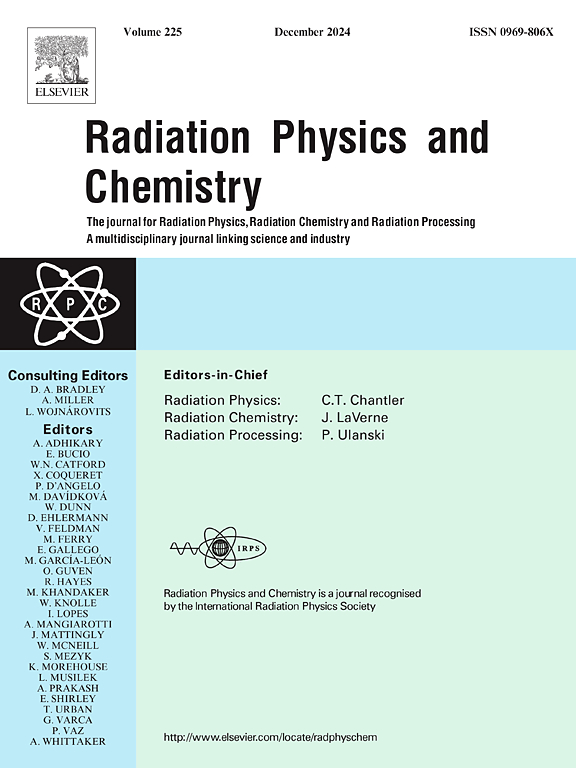密度对赤泥基盾构射线衰减特性的内在影响
IF 2.8
3区 物理与天体物理
Q3 CHEMISTRY, PHYSICAL
引用次数: 0
摘要
高能辐射屏蔽材料对于防止辐射危害至关重要。屏蔽层的原子序数和密度对高能光子的衰减都起着重要作用。本研究报告了密度对屏蔽的伽马射线衰减特性的内在作用。在2.12 ~ 5.23 g/cm3的密度范围内,通过热压实改变其孔隙率,而不是改变其成分或材料,制备了密度在2.12 ~ 5.23 g/cm3之间的辐射屏蔽层。赤泥(100%)(氧化铝工业废料)(RM)和赤泥:Bi2O3 (50:50 wt%)混合物(RMBi)被用来制造屏蔽。例如,在1000℃下施加0-39.02 MPa的压力,制备密度在2.63 ~ 5.23 g/cm3之间的RMBi样品。最终,随着压力的增加,RMBi样品的孔隙率从50%下降到2%。RMBi试样的抗压强度分别为6.8、101.8、243.2和283.3 MPa。采用22Na源(0.511 MeV和1.274 MeV)在窄波束几何条件下研究了屏蔽层的伽马射线衰减特性。RMBi样品的线性衰减系数μ从0.0176 mm-1增加到0.0272 mm-1,密度从2.63 g/cm3增加到5.23 g/cm3。除有效原子序数(Zeff)外,μ、半值层和平均自由程等衰减特性与Phy-X/PSD软件得到的理论值基本一致。采用137Cs点源(0.662 MeV)进行Compton后向散射实验测定Zeff。使用Phy-X/PSD软件计算时发现,随着屏蔽层密度的增加,RMBi样品的Zeff从20.99增加到40.92,而Zeff保持不变(19.90)。本文章由计算机程序翻译,如有差异,请以英文原文为准。

Inherent role of density on the gamma ray attenuation characteristics of red mud based shield
High-energy radiation shielding materials are vital for protecting against radiation hazards. Both the atomic number and density of the shield plays a prominent role in attenuating high-energy photons. This study reports the inherent role of density on the gamma ray attenuation characteristics of the shields. The radiation shields with various densities between 2.12 to 5.23 g/cm3 were fabricated by varying their porosity through hot compaction rather than altering their compositions or materials as reported in literatures. Red mud (100 %) (Alumina industry waste) (RM) and red mud:Bi2O3 (50:50 wt%) mixtures (RMBi) were used to fabricate the shields. For example, the RMBi samples with density varying between 2.63 to 5.23 g/cm3 were prepared by applying 0–39.02 MPa pressure at 1000 °C. Eventually, the porosity of RMBi sample has decreased from 50 % to 2 % while increasing the pressure. The compressive strength of RMBi samples are 6.8, 101.8, 243.2 and 283.3 MPa. The gamma ray attenuation characteristics of the shields were studied using 22Na source (0.511 and 1.274 MeV) in a narrow beam geometry. The linear attenuation coefficient (μ) of RMBi sample was found to increase from 0.0176 to 0.0272 mm-1 while increasing the density from 2.63 to 5.23 g/cm3. The attenuation characteristics such as μ, half value layer and mean free path are well in agreement with the theoretical values obtained through Phy-X/PSD software except the effective atomic number (Zeff). The Compton backscattering experiment was performed using 137Cs point source (0.662 MeV) to determine Zeff. The Zeff of RMBi sample was noticed to increase from 20.99 to 40.92 while increasing the density of the shield whereas the Zeff stays constant (19.90) when calculated using Phy-X/PSD software.
求助全文
通过发布文献求助,成功后即可免费获取论文全文。
去求助
来源期刊

Radiation Physics and Chemistry
化学-核科学技术
CiteScore
5.60
自引率
17.20%
发文量
574
审稿时长
12 weeks
期刊介绍:
Radiation Physics and Chemistry is a multidisciplinary journal that provides a medium for publication of substantial and original papers, reviews, and short communications which focus on research and developments involving ionizing radiation in radiation physics, radiation chemistry and radiation processing.
The journal aims to publish papers with significance to an international audience, containing substantial novelty and scientific impact. The Editors reserve the rights to reject, with or without external review, papers that do not meet these criteria. This could include papers that are very similar to previous publications, only with changed target substrates, employed materials, analyzed sites and experimental methods, report results without presenting new insights and/or hypothesis testing, or do not focus on the radiation effects.
 求助内容:
求助内容: 应助结果提醒方式:
应助结果提醒方式:


